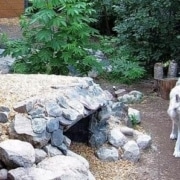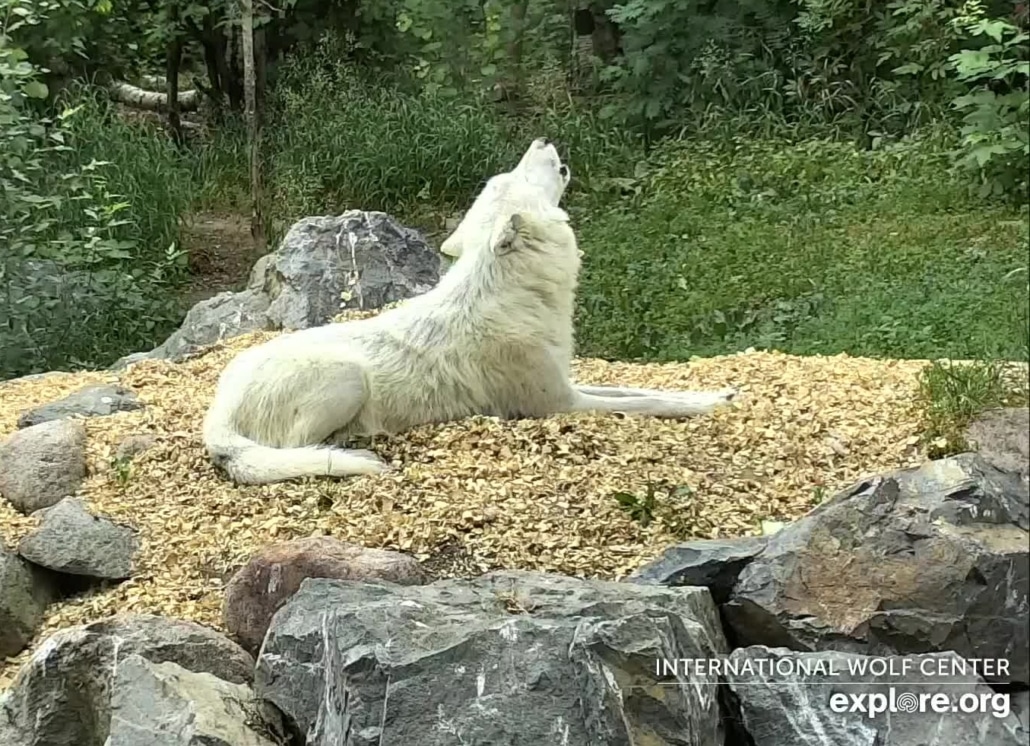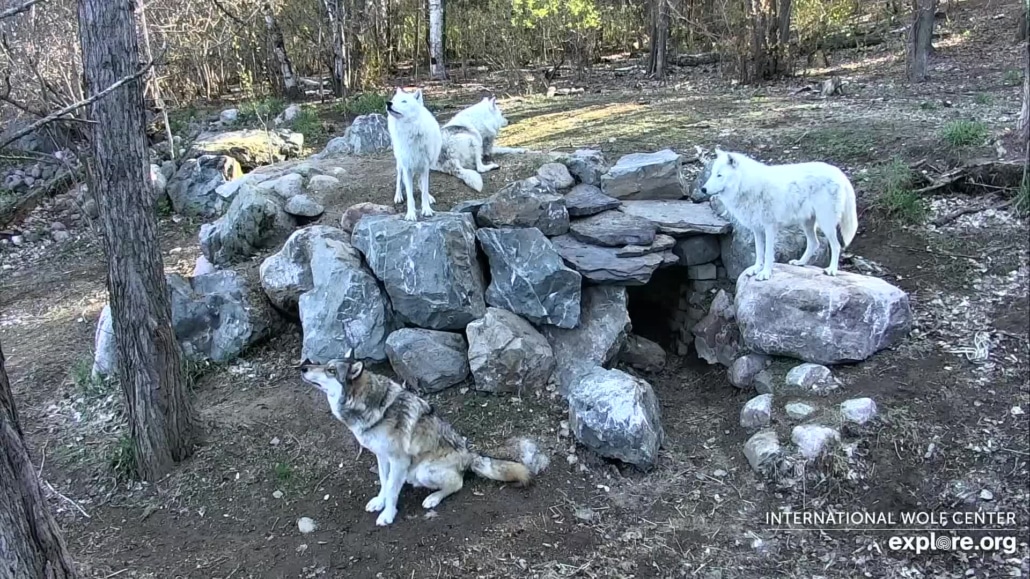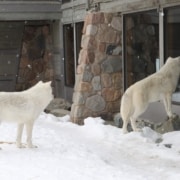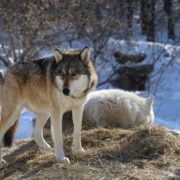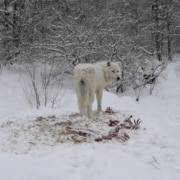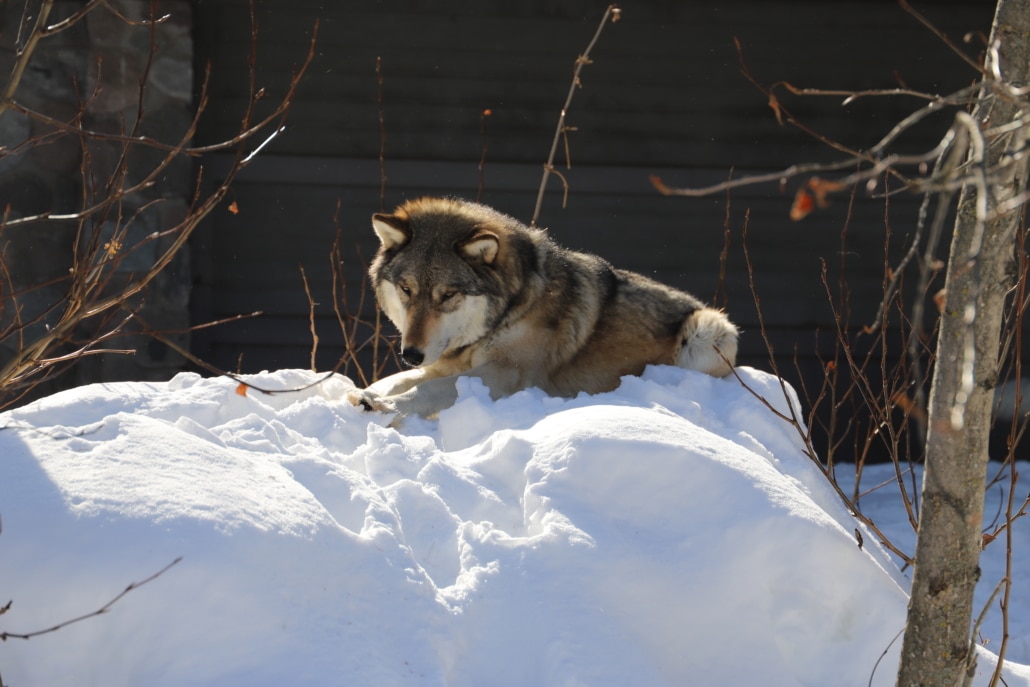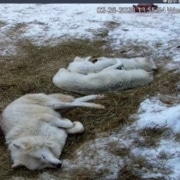Grizzer is managing well as a sixteen year old wolf in some excessive heat (at least for Northern Minnesota). We have a good cover of vegetation for shade, he has a staff hose down the retired areas to cool off the ground. We leave the Wolf Care Center door open allowing him to come in and rest on the cool concrete or is new orthopedic bed donated by wolf care support Kim Wheeler. He still has a bit more hair to shed, and thankfully is willing to allow staff the chance to pull lose strands of undercoat. He has had an added bonus of getting a deer leg during the summer time Behind the Scenes program. He certainly enjoys that. Staff are closely monitoring his weight for signs of any decline, but a recent blood sample indicated that he is in good health and he weighed in at 110 pounds.
Archives
It has been a while since we had time to post a log, but that’s not to say that the wolf care staff haven’t been busy. Since the Center closed as part of the Governor’s plan to reduce the spread of COVID 19, we have been doing the traditional summer preparations to ensure that the wolves are ready for the heat, the insects and the pack dynamics without the anticipated 4-year cycle of pups. To accomplish all of our goals, we install a UV filter system to clear the pond water of algae, high pressure misting systems to cool the wolves, made hundreds of enrichment activities, entered into an agreement with Explore.org to add additional cameras on the Exhibit and now that we are again open to the public, conduct multiple enrichment activities a day. The wolves are all dealing with the summer heat in a variety of ways. Denali seems to dominate time in the den and is often on display on the Explore.org north camera. Denali likes to park himself at the den entrance, keeping the other wolves from entering. Boltz tends to avoid the daytime heat and bugs all together, spending his days resting in the upper enclosure. Axel and Denali are food focused, so anytime there is an enrichment treat, Axel is usually first to arrive. The bonus of having the Explore.org cameras lies in the ability to see the wooded upper enclosure and the back of the main den. Grayson continues to show the most awareness of activity within and outside of the enclosure. He is a frequent howler in response to wild wolves, coyotes, even occasionally his retired neighbor, Grizzer.
We also had some auction items that didn’t receive bids from our earlier Wolf Care Auction, so we are posting the description of the item, the retail value of the product and the opening bid price. This will be managed through my email, with first come, first serve on bid items. Please follow this link to see the items including value and bid price set for the auction. Please send me the Item number and description of what you are interested in and your amount of bid price to curator@wolf.org. We will be accepting email bids until Friday April 10th. Thanks for your support of the ambassador wolves.
In order to reduce the risk of exposure between our wolf care team members, we have restricted wolf care to 4 individuals while the Governor’s Stay in Place order is active. If one of us gets sick, another team-member that has not been exposed can step in rather than the entire WC staff being exposed. Even though the Center is closed to the public, we want to assure people that the lives of the wolves has not changed, the morning med deliveries are the same, scat is collected, socialization is maintained and the staff are starting to work on the spring time activity within the enclosures. The staff have been actively packaging items for shipment to the winning bidders from our recent auction giving the wolves plenty to watch at the windows in the absence of our public during this period of closure. Axel and Boltz’s tension has calmed down and we are very happy to report the densite construction that was a Facebook Fundraiser last fall solved our flooding issues. We will continue to monitor it as we get rain today, but so far, it is staying dry. We do have several other dry spots to rest under the eaves and in the slated den, but the main den-site is the prime location in the Exhibit.
We had to cancel the Working for Wolves crew that had a tremendous group of people willing to come and help with our many projects including the wet, stinky hay, the dead trees and branches from winter storms, the improvement projects in retirement and the need to sterilize the lab for pups. So, the spring 2020 Working for Wolves crew will be the 4 of us; if you see us on camera with wheelbarrows and pitchforks, that is our next task. The wolves enjoy the insulating warmth of the hay all winter, but risk mold in warm, wet, weather is always a concern.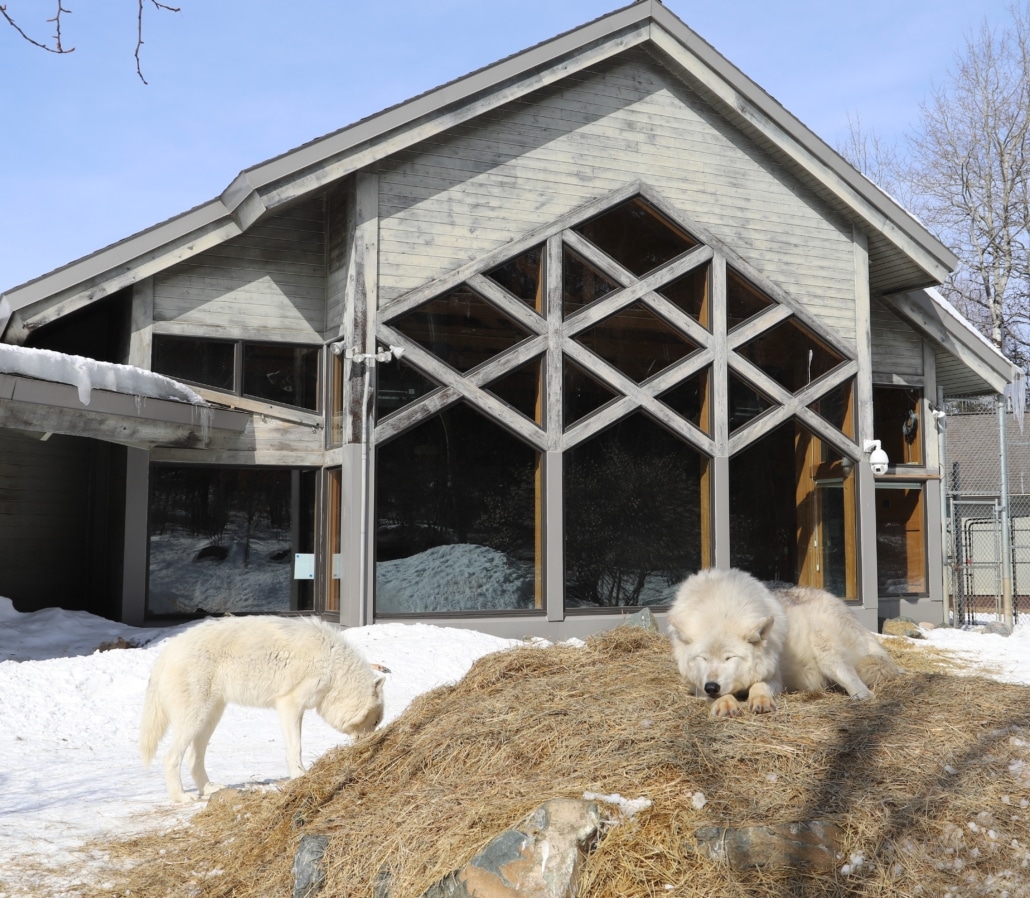
We did two special things today during our Free Friday Webinar broadcast this morning. We opened up the gate between the Pack Holding Area and the Exhibit to give Grizzer some stimuli with the Exhibit Pack. Grizzer was very relaxed, but it did get Grayson and Axel a little excited, and Grayson did some excited lunging and he and Axel redirected some dominance to Boltz. We will continue to allow these opportunities, expecting the more frequent the experience, the less intense the response. This is the area that the pups and the Exhibit Pack members will interact, so we don’t want to create a negative conditioning to the area.
The second special thing we did for Grizzer is to get his weights. He currently weighs 118 pounds, which is a nice weight for a nearly 16 year old wolf. Here is the pattern of his last few years to see that they lose weight during the heat of the summer, gain weight over the winter and start to reduce again as spring approaches.
| 3/2/2018 | Grizzer | 118 | 13 years 10 months |
| 4/18/2018 | Grizzer | 114.6 | 13 years 11 months |
| 6/1/2018 | Grizzer | 115 | 14 years 1 month |
| 7/2/2018 | Grizzer | 112 | 14 years 2 month |
| 8/23/2018 | Grizzer | 120 | 14 years 4 months |
| 6/28/2019 | Grizzer | 121 | 15 years 2 months |
| 8/12/2019 | Grizzer | 118 | 15 years 3 months |
| 12/9/2019 | Grizzer | 125 | 15 years 7 Months |
Temperatures have been rising in Ely, and that means snow is starting to melt. If you watch the IWC webcams, you may have noticed the Pack Holding Den looks a little shorter than usual. Wolf care staff took advantage of a warm, nearly 50-degree day, and were able to remove most of the compacted snow and hay on top of the den. Grizzer watched curiously as a wheelbarrow was brought in to aid in the removal of the old hay. Contractors have been on site this week, working on adding additional roofing to the Pack Holding Area. This is the area that the new pups will utilize when they are old enough to spend time outside. You may notice that we use a lot of dark wood around the fence-lines. This darker color helps absorb heat, creating a quicker snow melt for walking paths. The roofing will provide additional protection from the elements, for both the older wolves and the new pups.
Wolf Log written by Assistant Curator: Leanne Martin
As we move closer to Spring, temperatures are warming up and snow is beginning to melt during the day. If you recall, in the Fall of 2019 we had some rock work done on the main den in the Exhibit. One of the main goals of that project was to reduce the amount of flooding in the den during the Spring melt. We are happy to say that so far, the den is nice and dry! Denali and Boltz frequently sleep in that den, so it is important that it is kept dry and comfortable for them. Axel and Grayson seem to prefer sleeping on the hay near the viewing windows, and on the pond pumphouse.
Wolf Log written by Assistant Curator: Leanne Martin
This past weekend, the weather warmed considerably giving us a reminder of the upcoming change of the season. This resulted in some reduced activity within the Exhibit Pack, but in true Minnesota form, winter returned with some snow and sub-freezing temperatures. The wolves base their activity patterns on the weather, switching from a diurnal (daytime mode) in winter, to the crepuscular activity of dawn and dusk in fall and spring to a nocturnal exhibit during the warmest summer days. In this week’s photo, Axel has found the remnants of the cover hay before the snow blankets the Exhibit. But, shortly after the snowfall, the warm March sun can quickly motivate the wolves into a nap, which appears to be Boltz’s intentions here.
Whenever we discuss social behavior, we always reference the importance of sibling bonds. When we adopt pups, we try to get pups from the same litter. This doesn’t mean that litter mates or genetically related pack members won’t have strife, but in our experience, there seems to be moments when that bond is more evident. Today, on the surveillance camera, we caught a mid-day nap with Axel, Grayson and Denali. Axel is resting his paw along Grayson’s back. At this moment in time, life is compatible between the young brothers.
In the Exhibit Pack, staff have been successful with helping Axel work through some of his focus and excitement. One way to calm Axel is with bodywork techniques. The bodywork techniques staff use are the same ones that were used on Luna. Axel is quite receptive to the bodywork, and he will often present himself to staff for it.
Of course, distractions are still an important tool staff use to ease tension within the pack. One of Axel’s favorite distractions are freeze dried venison cakes. We go through these cakes quickly and are currently running low on our supply. The International Wolf Center has an AmazonSmile Wishlist, so if you are interested in donating a bag of venison cakes, follow this link to the Wishlist.
Boltz is back interacting with the rest of the pack. He likes to spend time with Denali, and still seeks Denali out as a source of comfort. Boltz’s confidence has greatly improved, and he is no longer intimidated by Axel’s presence. In fact, Boltz has been chasing after Axel and Grayson during the afternoon chases the pack likes to engage in. Spring must be in the air as the winter dominance starts to diminish.
Wolf Log written by Assistant Curator: Leanne Martin

The International Wolf Center uses science-based education to teach and inspire the world about wolves, their ecology, and the wolf-human relationship.

